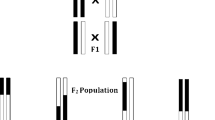Summary
New sources of genetic polymorphisms promise significant additions to the number of useful genetic markers in agricultural plants and animals, and prompt this review of potential applications of polymorphic genetic markers in plant and animal breeding. Two major areas of application can be distinguished. The first is based on the utilization of genetic markers to determine genetic relationships. These applications include varietal identification, protection of breeder's rights, and parentage determination. The second area of application is based on the use of genetic markers to identify and map loci affecting quantitative traits, and to monitor these loci during introgression or selection programs. A variety of breeding applications based on these possibilities can be envisaged for Selfers, particularly for those species having a relatively small genome size. These applications include: (i) screening genetic resources for useful quantitative trait alleles, and introgression of chromosome segments containing these alleles from resource strain to commercial variety; (ii) development of improved pure lines out of a cross between two existing commercial varieties; and (iii) development of crosses showing increased hybrid vigor. Breeding applications in segregating populations are more limited, particularly in species with a relatively large genome size. Potential applications, however, include: (i) preliminary selection of young males in dairy cattle on the basis of evaluated chromosomes of their proven sire; (ii) genetic analysis of resource strains characterized by high values for a particular quantitative trait, and introgression of chromosome segments carrying alleles contributing to the high values from resource strain to recipient strain.
Similar content being viewed by others
References
Beckmann JS, Soller M (1983) Restriction fragment length polymorphisms in genetic improvement: methodologies, mapping and costs. Theor Appl Genet 67:35–43
Bishop D, Skolnick MH (1980) Numerical considerations for linkage studies using polymorphic DNA markers in humans. Banbury Rep 4: cancer incidence in defined populations. Cold Spring Harbor Laboratory, Cold Spring Harbor, pp 421–433
Botstein D, White RL, Skolnick M, Davis RW (1980) Construction of a genetic linkage map in man using restriction fragment length polymorphisms. Am J Hum Genet 32:314–331
Geldermann H (1975) Investigations on inheritance of quantitative characters in animals by gene markers. 1. Methods. Theor Appl Genet 46:319–330
Grodzicker T, Williams J, Sharp P, Sambrook J (1974) Physical mapping of temperature-sensitive mutations of adenoviruses. Cold Spring Harbor Symp Quant Biol 39:439–446
Kluge R, Geldermann H (1982) Effects of marked chromosome sections on quantitative traits in the mouse. Theor Appl Genet 62:1–4
Law CN (1966) The location of genetic factors affecting a quantitative character in wheat. Genetics 53:487–498
Mather KM, Jinks JL (1971) Biometrical genetics. Chapman and Hall, London
McMillan I, Robertson A (1974) The power of methods for the detection of major genes affecting quantitative characters. Heredity 32:349–356
Owen JB (1975) Selection of dairy bulls on half-sister records. Anim Prod 20:1–10
Patterson FL, Schafer JF, Caldwell RM (1968) Effect of selected linkage blocks on yield and yield components in wheat. In: Finlay KW, Shepard KW (eds) Third Int Wheat Genet Symp. Aust Acad Sci, Butterworths, Canberra, pp 88–92
Silver H (1978) Paternity testing. In: Silver H (ed) Seminar presented by the Committee on Technical Workshops of the Am Ass Blood Banks. New Orleans, Louisiana
Simmonds NW (1979) Principles of crop improvement. Longman Group, London
Soller M (1978) The use of loci associated with quantitative traits in dairy cattle improvement. Anim Prod 27:133–139
Soller M, Brody T, Genizi A (1979) The expected distribution of marker-linked quantitative effects in crosses between inbred lines. Heredity 43:179–190
Soller M, Genizi A, Brody T (1976) On the power of experimental designs for the detection of linkage between marker loci and quantitative loci in crosses between inbred lines. Theor Appl Genet 47:35–39
Soller M, Genizi A (1978) The efficiency of experimental designs for the detection of linkage between a marker locus and a locus affecting a quantitative trait in segregating populations. Biometrics 34:47–55
Soller M, Plotkin-Hazan J (1977) The use of marker alleles for the introgression of linked quantitative alleles. Theor Appl Genet 51:133–137
Solomon E, Bodmer WF (1979) Evolution of sickle variant gene. Lancet I: 8122:923
Spickett SG, Thoday JM (1966) Regular responses to selection. 3. Interaction between located polygenes. Genet Res 7:96–121
Stuber CW, Goodman MM, Moll RH (1982) Improvement of yield and ear number resulting from selection at allozyme loci in a maize population. Crop Sci 22:737–740
Tanksley SD, Rick CM (1980) Isozymic gene linkage map of the tomato: applications in genetics and breeding. Theor Appl Genet 57:161–170
Tanksley SD, Medina-Filho H, Rick CM (1981) The effect of isozyme selection on metric characters in an interspecific backcross of tomato-basis of an early screening procedure. Theor Appl Genet 60:291–296
Tanksley SD, Medina-Filho H, Rick CM (1982) Use of naturally-occurring enzyme variation to detect and map genes controlling quantitative traits in an interspecific backcross of tomato. Heredity 49:11–25
Thoday JM (1961). Location of polygenes. Nature 191:368–370
Weller J (1983) Genetic analysis of quantitative traits in Lycopersicon (tomato) by means of genetic markers, including a comparison of an improved cultivar and a wild variety (in Hebrew, English summary). PhD Thesis, The Hebrew University of Jerusalem, Israel
Zhuschenko AM, Samovol AP, Korol AB, Andryushchenko AB (1979) Linkage between loci of quantitative characters and marker loci. 2. Influence of three tomato chromosomes on variability of five quantitative characters in backcross progenies. Translated from Genetika 15:672–683
Author information
Authors and Affiliations
Additional information
Communicated by A. Robertson
Contribution from The Agricultural Research Organization, The Volcani Center, Bet Dagan, Israel, No. 767-E, 1983 Series
Rights and permissions
About this article
Cite this article
Soller, M., Beckmann, J.S. Genetic polymorphism in varietal identification and genetic improvement. Theoret. Appl. Genetics 67, 25–33 (1983). https://doi.org/10.1007/BF00303917
Received:
Accepted:
Issue Date:
DOI: https://doi.org/10.1007/BF00303917




